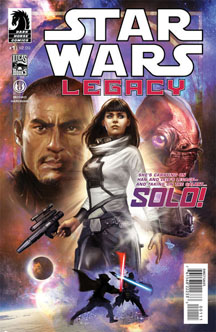After Cade Skywalker’s saga came to a natural conclusion in 2011, Dark Horse launched two new titles to satiate fans of “Legacy.” The work of John Ostrander and Jan Duursema could be found in “Dawn of the Jedi,” which started in 2012, while the “Legacy” era continued in “Legacy Volume II” in 2013. Although both were intended to be ongoing titles, they were canceled when the “Star Wars” license switched to Marvel – “Dawn” after 15 issues and “Legacy Volume II” after 18.
Co-written by Corinna Bechko and drawn by Gabriel Hardman, “Legacy Volume II” is set 138 years after “A New Hope,” right after the conclusion of Cade’s adventures. At the end of Ostrander’s “Legacy: War” Issue 6, a Galactic Federation Triumvirate declared its rule of the galaxy in the wake of wiping out Darth Krayt’s Sith Empire. This new government aims to set up communications arrays all the way to the Outer Rim to show the citizenry its goodwill. At no point do the authors explain how the Triumvirate government is funded, if a planet’s allegiance to the Triumvirate is voluntary or mandatory, or – most crucially – how three different philosophies can share rule.
The Triumvirate consists of the Empire, the Galactic Alliance and the Jedi, through the personages of Empress Fel, Admiral Gar Stazi and Master K’Kruhk, respectively. They often bicker with each other. For example, Fel uses the word “Empire” to describe the government, K’Kruhk chastises her and she says “You know what I mean.”
But, of course, an empire and an alliance are – or, at least, should be — different things. Based on what we know of these organizations throughout “Star Wars” lore, particularly in the wake of “Legacy”:
- The Empire is a mix of communism and Catholicism. It desires for the state to control all markets and claims its divine right to rule through the Force, as embodied by its Papal equivalent, the emperor or empress. The one failsafe is that an Imperial Knight may kill the emperor if he strays from the light side; indeed, Antares Draco kills the genocide-seeking Emperor Roan Fel at the end of “Legacy,” citing this dictum.
- The Galactic Republic is analogous to the modern United States. Broadly speaking, competition is allowed in most industries, but the state wields a heavy regulatory hand and taxes almost everything. Like the Empire, it boasts a strong military (indeed, Admiral Gar Stazi’s fleet is the only aspect of the G.A. seen in “Legacy”), but whereas the Empire is prone to conquer worlds, the G.A. is more likely to seek voluntary memberships.
- The Jedi are the oddest part of the Triumvirate, because ruling over others is not part of the Jedi philosophy. While presumably funded by taxpayers through a pact with the G.A. (and before that, the New Republic and the Old Republic), one gets the sense that the Jedi would not use military or police force to acquire those funds if the pact was dissolved. Although they made a major misstep during the Clone Wars by choosing a side, the Jedi are traditionally “the guardians of peace and justice” and arbiters of disputes, not an organization that has a stake in one person’s, party’s or government’s power.
On the character front, “Legacy II” features Ania Solo, a junk dealer in the Carreras System whose outlook is similar to Cade Skywalker’s: She just wants to be left alone to make a living. She’s a bit nobler than Cade, who as a pirate subscribed to the “take from criminals and give to me” philosophy. Ania tends to operate above-board, although when she acquires a lightsaber she makes an enemy of the Carreras Major police force, which is reducing crime in totalitarian fashion so it can impress the Triumvirate and assure it that putting a comm array there was the right choice.

The “Legacy Volume II” guide at the back of the fourth trade paperback states that Han is Ania’s great-great grandfather, just as I assume Luke to be Cade’s great-great-grandfather. A quick mathematical calculation suggests that Jaina is probably Ania’s great-grandmother rather than Jacen being Ania’s great-grandfather and Allana being Ania’s grandmother. There are too many years between Allana’s life and Ania’s to account for only one generation, whereas two generations could fit between Jaina and Ania. It is unknown why Ania’s last name is Solo rather than Fel.
Along for the adventure with Ania are her Mon Cal friend Sauk, the reprogrammed assassin droid AG-37 and Imperial Knight Jao Assam. As the Triumvirate and Imperial Knight Yalta Val (Darth Wredd’s titular “Prisoner of the Floating World” in Issues 1-5) wring their hands, Ania’s group resolves to go after Darth Wredd, believing he is a serious threat to galactic peace. IG-88 lookalike AG-37 is the most intriguing link to Ania’s past, as he tells her he is looking after her because he always repays his debts (presumably to Han). He also informs her that her bloodline isn’t solely one of royalty (a lifestyle and status Ania rejects on philosophical grounds), as Han Solo was a smuggler and a hero.
While I would choose Duursema’s clean lines and consistent likenesses over Hardman’s dark, stylized work if given the choice, the grittier style fits “Legacy Volume II.” Bechko comes up with great set pieces, including a sunless planet hidden within a nebula and the idea that the Triumvirate has given up on the Dac system, opening it up to chaos or villainy. “Outcasts of the Broken Ring” (6-10) shows us that Darth Luft has taken over the Dac shipyards and is using slave labor to construct a military fleet. It’s particularly insidious that he lures Mon Cala and Quarren back to their poisoned homeworld with the false promise of a restoration project.
An underwater rescue on the empty, poisoned Dac – complete with skeletons – is eerie, and another imaginative set piece comes when water-filled holds on the shipyards get opened to space, where the water turns to ice. In one dramatic sequence, our heroes attempt to shut the airlock before the ice cracks.
At the end of Ostrander’s “Legacy,” we saw that Darths Nihl, Maladi, Talon and Wyyrlok IV are out there in the galaxy, but Bechko opts not to use them in these first 10 issues. Darths Wredd and Luft are not particularly original, with their broad desires to rule to the galaxy (although I do like how Wredd uses Ania’s group as a weapon against Luft). But on the other hand, the fragile Triumvirate structure is a pot ready to boil over, and I’m enjoying the main characters and their relationships.

